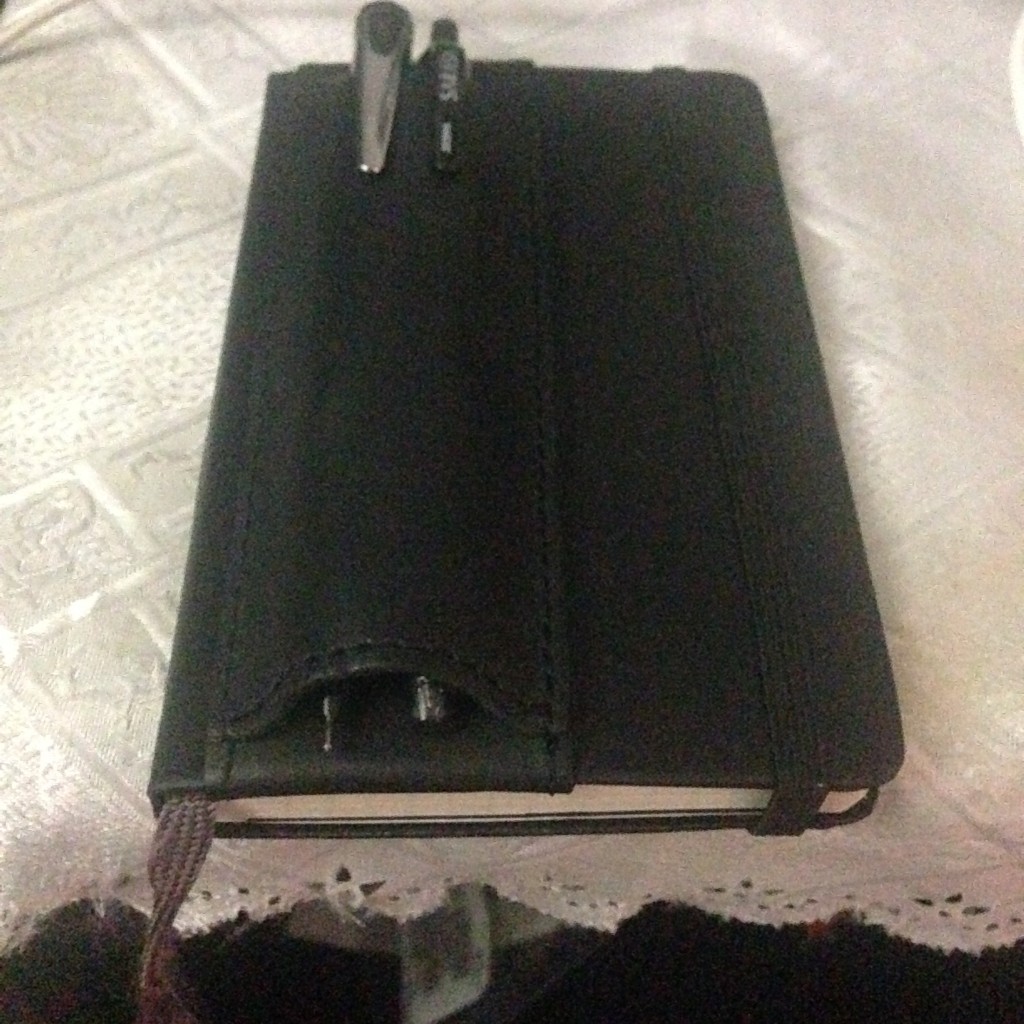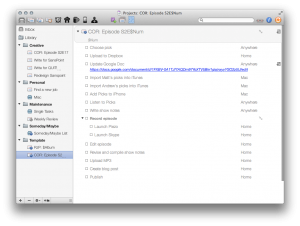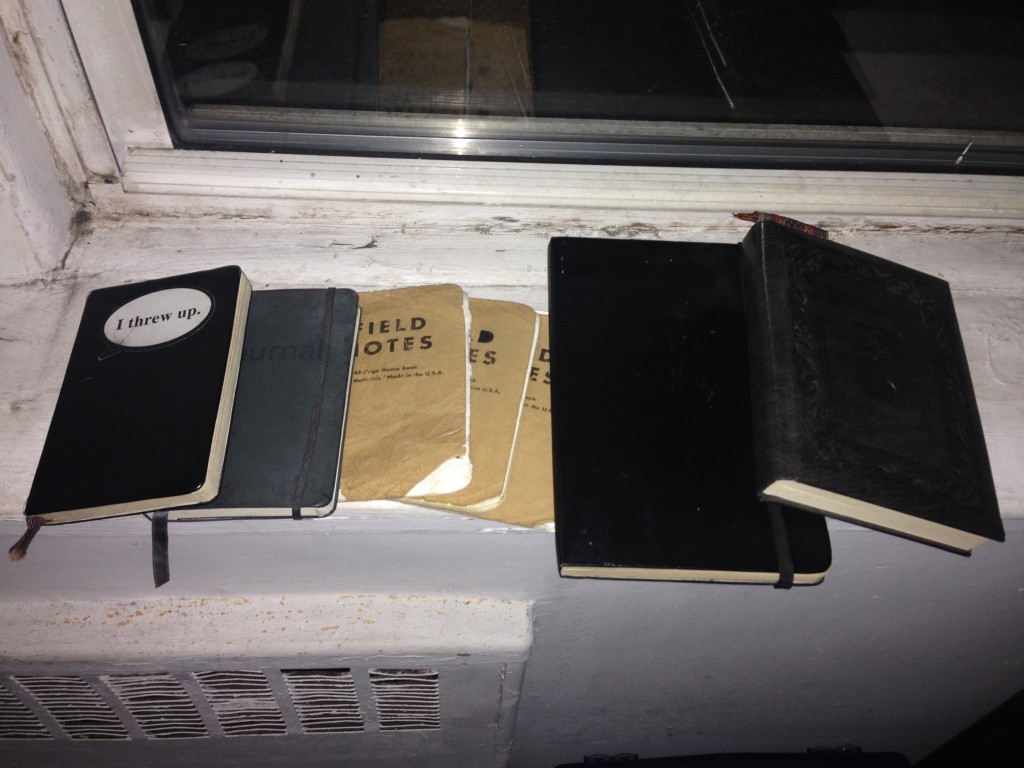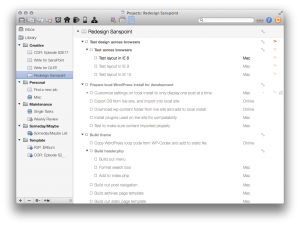Back in November, I started keeping a notebook with the Bullet Journal technique. It’s been a slow process acclimating myself to writing things down when it occurs to me, instead of counting on my memory, or reaching for my iPhone. The earliest entries are a mishmash of things, from important ideas and notes on books, to stuff I could—and should—track elsewhere like my daily steps from my pedometer. Under one day’s entry, I have the line “Nap” for some reason. I guess Past Me took a nap that day. Good to know.
I’ve learned that a notebook isn’t good for how I do work with a larger scope and time frame, but it’s great for figuring out my day-to-day. We keep an editorial schedule at my job, and I’ve taken to writing the day’s items in my notebook each morning. That day’s entry becomes my own form of Patrick Rhone’s “Today Card,” only in a longer-lasting form. When the particular item for that day is done, a quick check in the box lets me know. If there’s any changes from the schedule, or important notes for that day’s projects, I have a way to remind myself.
I could do all of this with OmniFocus, but to capture the daily projects I do at work would be more of a pain to type them in on my iPhone or iPad than to just write the darn thing down. 1 Plus, as nice as it is to go into the “Completed” Perspective in OmniFocus and see all the things I’ve done, having a physical archive just feels better. This is for me, not for anyone else. While it might be nice to imagine scholars or archeologists pouring over the notebooks of some 30-year old Web Producer in the mid-2010s, the benefits of an annotated life are worth it just for me. Future Me will be interested in what Past Me was doing.
Future Me, however, also needs to have things in a trusted system, ready to be viewed when he needs them, pre-broken up into little discrete nuggets of work and time. Future Me needs this so he knows what to do at 10:48 AM, when the creatives for the items on the schedule aren’t in yet. That’s where OmniFocus comes in, and where apps like Daily Routine come in. They give Future Me, who isn’t going to think to flip back a few pages in his notebook just to find the task due by 5PM today that he got two weeks ago, or the right information he needs. Because, if there’s one thing I’ve learned about Future Me: he’s just as forgetful as Past Me.
My Dad used to keep an 1950 Plymouth in the garage of our Northeast Philadelphia rowhouse. He thought that one day he’d have the time, energy, tools, and whatever, to put it back in working order. Until then, it was just a hulking metal mass that stood in the way of getting Christmas decorations out. The car sat in the garage from before I was born until my early twenties, when he wised up and sold it to a new neighbor who actually restores cars for a living.
I’ve never restored a car. In fact, mechanical aptitude is one of the few things I didn’t inherit from my Dad. My Dad knows how to do a lot of physical, real things. He was a plumbers assistant, a carpenter, an electrician, and for the last decade of his career, a construction inspector for the City of Philadelphia. He could build things and he could rebuild things. Me? Anything more complicated than a LEGO set or IKEA furniture is asking for trouble. Instead, I’m the one they he turns to—the whole family turns to—for tech support. This is why I insisted that my parents buy a Mac not long after I switched.
Michael Lopp recently wrote about “The Builder’s High” he gets from making things. Writing gets him high, and I sympathise. I only know how to build two things, one is an essay, another is a site to host essays. Yet, I’ve only gotten that builder’s high a precious few times in my life. One time was when I was seized by inspiration and threw together a gorgeous mock-up redesign of a friend’s website in Photoshop that never got used. Another time is when I started a novel one night in December of 2008—the same novel I quit to focus on this thing.
Building stuff is hard. I could get all into Mihályi CsÃkszentmihályi, and Flow, and all that stuff, but I suspect you’ve read all about that elsewhere. I don’t know if it’s gotten harder since we started, as Rands says, “swimming in everyone else’s moments, likes, and tweets.” There’s nothing stopping us from turning off the stream if we truly want to. Since the Industrial Revolution, there’s always been something more appealing than expending the effort to build things, whether it’s TV, radio, books, or just kicking stones. Time was most everyone learned how to play an instrument, but not everyone wrote music. It takes a certain mindset to want to struggle and beat your head against the wall to make something the world has never seen before. When it’s done, though, it feels great.
It doesn’t feel nearly as good to read a Twitter timeline, or to post on one. It does feel good, on some level, or we wouldn’t do it. We share our moments, and we read others shared moments, and for most people, that’s enough to satiate the voice that screams at us to make something and have it be seen. For people who want to do more, it’s good enough to be dangerous. It takes a little vigilance to keep those moments from devaluing our own. We can drown in other people’s moments, and we can lose our moments by focusing too much on sharing them. There’s a balance to be struck, and it’s harder for some of us to strike it than others. Being aware of this give us something to strive for. I’ll never be as handy as my Dad, but as long as I can build—and rebuild—something, I’ll know I have something to be proud of.
On November 14th, I posted an essay about analog productivity systems. That same day, I went out and purchased a brand new square ruled, pocket Moleskine notebook , with the intent of giving Bullet Journal a try. It’s been a about a week and a half, and I’m ready to report my initial findings. It’s been interesting.
, with the intent of giving Bullet Journal a try. It’s been a about a week and a half, and I’m ready to report my initial findings. It’s been interesting.
Setup and First Impressions

My Bullet Journal, Closed
I typically carry a pen, everywhere I go. Oddly, the day I bought my to-be Bullet Journal notebook, I left the apartment without it, thus forcing me to wait until I got home to tear into the setup process. I also made sure to listen to Ryder Carrol’s interview on the GTD Virtual Study Group podcast.
Bullet Journal is not made for pocket notebooks, though it’s certainly doable. My monthly calendar for november spans across two pages, and my monthly task list takes up the bottom half of the second page. This isn’t the most aesthetically pleasing option, but I’ll trade aesthetics fro portability. Besides, my atrocious handwriting is going to ruin any elegance the system has.
I also noticed that the Monthly Calendar pages do not handle multiple events well. On the 15th, I had three appointments to keep in mind, but I only had room for one on the page. As Bullet Journal encourages succinctness—a quality I lack, as you’ll know from reading other things on this site—I’ll blame myself for this one.
Usability
Great. Just great. I had the opportunity on day one to really give my Bullet Journal a workout when I attended a lecture at Columbia University on news, computational linguistics, and social media. I scribbled away a page and a half of bulleted notes that are succinct enough to recreate the interesting parts of the lecture. That the notes take up a spread in the middle of my November daily calendar pages doesn’t bother me, as I have both the index and my Moleskine’s built in bookmark to keep my place.
I did purchase an accessory to make sure I wasn’t without a pen anywhere I carried my notebook: a double pen pocket notebook Quiver. It took its time getting to me, but I can’t imagine carrying my notebook around without it. I keep a Zebra Sarassa pen in there, along side a Pentel mechanical pencil, just in case there’s something tentative to put down.
One thing I noticed is that people really like to see you write stuff down in a notebook. When I type things people tell me into my phone, there’s no excitement. On several occasions, writing stuff in my notebook caused people to react very positively. I especially noticed this effect at a technology event I attended, sponsored in part by Google. Let’s see Google Glass be this efficient and reliable, huh?
Where It Fits In

Nothing incriminating, I think.
What have I been writing in my Bullet Journal? Whatever seems relevant. Daily steps, notes on calls and meetings, what jobs I’ve applied for, post ideas for Sanspoint and elsewhere—anything that I’ll want or need to know later. Bullet Journal’s found a niche for me as a structured way to capture little bits of data I collect throughout the day, when I know I’ll need or want to refer to them again. Not every day gives me data to collect, but it’s good to have a structure.
Bullet Journal is not, however, a task management system for me. If one of those pieces of data I happen to collect is a task, then I collect it and mark it as such with a square box for a bullet. However, I still keep all my to-dos in OmniFocus, where I can manipulate them, organize them, and build them out into projects or subtasks, as necessary for my poor, addled mind. I admire people who can see a task like “Redesign website†and handle it from there. I need more detail, and while Bullet Journal can do that, I would prefer to keep it as a capture system.
What To Improve
My handwriting. And remembering to actually write stuff down when I think of it.
Final Thoughts
I don’t know if anyone necessarily needs a full on system to use something as simple as a notebook. It’s pretty intuitive. As Merlin Mann said, “Nothing doesn’t go in here.†What I like about having a system is that it’s a good MacGuffin for getting me to crack open the damn thing every now and then and scribble something down. More importantly, half of the value of a notebook is the ability to go back and see a snapshot of your life. It’s something I’ve missed out on. Hopefully, using Bullet Journal will give me notebooks full of good stuff to look back on in time.
There’s a debate brewing around Michael Lopp’s (aka Rands) reasons for ditching his task manager.
The issue that pushed me over the edge had nothing to do with functionality or stability, but stagnation. I was performing my morning scrub on Things when I realized that nothing much had changed in Things UI in, well, years.
— R.I.P. Things – Rands in Repose:
Of course, if the app works, there’s little reason to ditch it just because it hasn’t seen a major update. Law offices used WordPerfect 5.4 for DOS for years until Microsoft Word finally superseded it in the 90s.
And yet, having switched from Things to OmniFocus—twice—I can see why Rands jumped ship. Things is a very simple application, for good and for ill. If your task management needs run into the limits of what you can do with the app, you can quickly get frustrated. OmniFocus, though it has not so much of a learning curve as a learning right-angle, is much more open and flexible as to how you can use it. It can open up a lot of new ways to get things done.
Rands’s new tool of choice, Asana seems to be doing the same thing:
It’s added a little more friction and a little more religion to my task tracking process, but it’s also done something Things hasn’t done in years – it’s new bevy of functionality has me asking one of my favorite engineering questions, “How can I do this better?â€
Which leads me to Daniel Jalkut’s rebuttal, and one section in particular:
[W]hat really frustrates me in this case is the software has served him perfectly, and he thanks it with a slap to the face. It’s one thing to denigrate a product for failing to meet your expectations, or for exhibiting a clear lack of craftsmanship, but Lopp admits that those problems do not apply…
Has the software been serving him perfectly? I’d say not. I remember the absolute frustration while Cultured Code took two years to figure out how to sync tasks across devices. The first iPad hadn’t even been released when they started working on the problem. I’ve said that “right trumps fast”, but OmniFocus beat them to the punch. This was why I jumped to OmniFocus the first time, once the dance of syncing my tasks with Things on my iPhone every day grew frustrating. I don’t see it as a slap in the face. I paid $70 for all three versions of the App. I think that’s compensation enough.
This is why I sympathize with Rands’s complaint that Things has “stagnated.” He’s wondering if there are ways that he could improve how he’s working, and that involves new tools. As long as it doesn’t keep you from doing the work, what harm is there in trying other tools? Especially if you feel limited by what you’re using. Enter Ben Brooks who has been inspired by the discussion to do the same thing.
My goal isn’t to try and leave OmniFocus, but to make sure OF still is the best solution for me. OF has gotten so ugly on the Mac and iPad I almost refuse to use it in those places. Which means I am essentially using the iPhone app, and even the new iPhone app isn’t the best looking app
— Moving for the Sake of Moving — The Brooks Review
I disagree about the iPhone app, though doing my reviews on the iPad often makes me frown when I see the old iOS 6-style UI. I’ve also tried the OmniFocus 2 betas and I like the direction the Mac interface is taking, though I switched back to OmniFocus 1 because I actually needed to get work done. Still, it’s Ben’s opinion, and he’s entitled to both it, and to try and find ways to optimize his workflow.
Which leads to Patrick Rhone’s series of posts on App.Net on simple systems and the concept of the no-grade. There’s no question that any digital task manager adds a lot of complexity to something that should be simple. I can only speak for myself, but having a complicated system I understand and can manipulate to a great degree really helps me a lot. I’ve tried simple systems, including pen and paper, and have gotten lost.
However, I have (re-)introduced pen and paper to augment how I get stuff done, via Bullet Journal. I see it as a way to supplement the digital system I’ve built. I’ll provide a full report on how well it’s been working once I’ve spent more than a few days with it. So far it’s been helpful, but I wouldn’t have tried it unless I’d noticed a dissatisfaction with OmniFocus and my existing system. Switching for the sake of switching can be a waste of time. Switching for the sake of trying to improve something can have huge benefits. It never hurts to at least dip in your toe.
Patrick Rhone has a very simple productivity system. He writes three things he wants to get done on an index card, and he keeps a running journal in a notebook with a system he calls “Dash/Plusâ€. I’m not so good at remembering to write things down, but I’ve taken the idea of Patrick’s “Today Card†and incorporated it into OmniFocus, flagging three important things I want to get done today. I don’t always succeed at all three, but getting at least one done means I’m moving in the right direction.
But reducing the power of OmniFocus to something as simplistic as a single window with three things to click off has me reconsidering my stance on analog productivity. It hasn’t helped that I’ve spent a little more time in book stores, recently. The stacks of square-ruled Moleskine notebooks have been taunting me to pick them up and try using the Bullet Journal system during my day. I also notice my poor Hipster PDA, getting battered in my pants pockets, its bright white index cards tarnished and battered—but ink free. (And not because I don’t carry a pen.)

An overly complex OmniFocus task list I might not need
When I wrote about eschewing analog workflows back in March, the focus was on sustained writing, but some of the points extend to purely “getting things done,†too. The default behavior when I have any new stimulus that needs capturing, is to whip out my phone and type it up as a note in Drafts. It’s my instant collection bucket, no more than two taps away from sending it where it needs to be. It’s ingrained enough that it’s second nature, and why I make sure to keep Drafts in my iPhone and iPad docks.

A few of the notebooks I’ve yet to fill up over the past seven or eight years.
But the siren call of a low-tech solution to keeping track of things still appeals to me in some way. I look at the piles of stuff in OmniFocus, and wonder if I need such hyper-detailed lists of tasks for some of my projects, especially if I’m just doing three “things†per day. I wonder if I couldn’t just train myself to reach for a pocket notebook and pen when I need to take something down, instead of my phone. I wonder if I could actually improve my atrocious handwriting with the practice. I wonder what I’m missing out on by not having a hard copy record of my day, my ideas, and my life.
And I also realize that twice—more than twice—I’ve “burned my life’s work.†I’ve turned piles of my writing from adolescence and (very) early adulthood into nothingness with a keystroke, but I have a small stack of half and quarter full notebooks that remain. They’re full of journal entries, snippets of fiction, doggerel verse, and random notes. The digital fragments of my old lives were much easier to destroy.

The sort of detailed OmniFocus task list I do need
In all honesty, I do need the hyper-detailed task lists I keep in OmniFocus—at least for some things. I do find it easier to write with a keyboard on my computer or iPad instead of on paper. I have a system that, more-or-less works. I also don’t have to completely give it up to try going analog for some things. Perhaps I’ll indulge my curious impulses, buy a new, empty square ruled notebook, and give the Bullet Journal system a go. A hybrid system may work, or it may not. It would be foolish of me to dismiss it without trying it first. I’ll report back on my findings.




